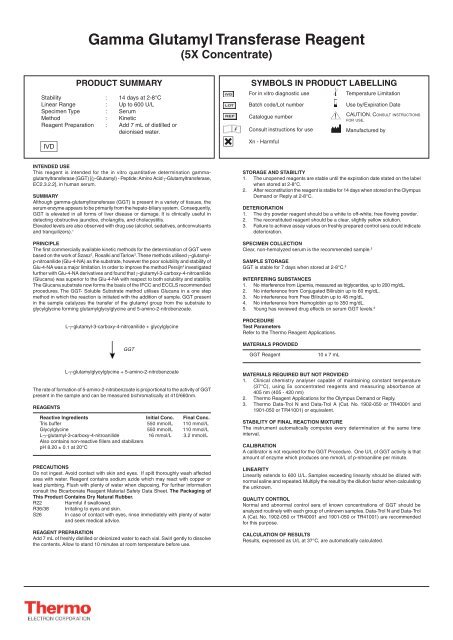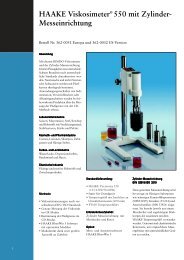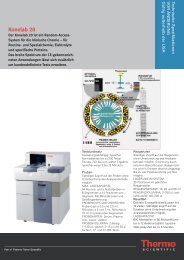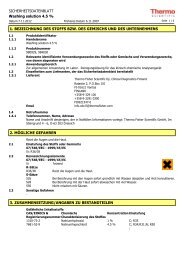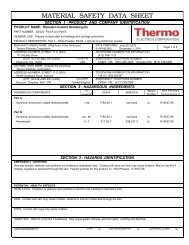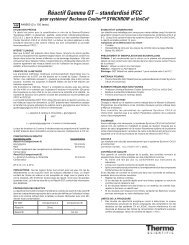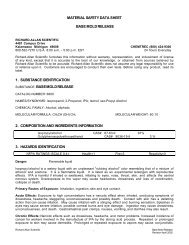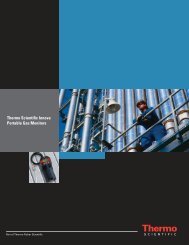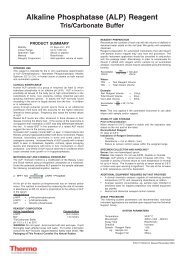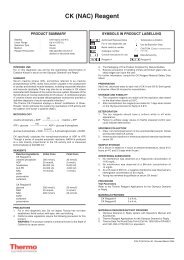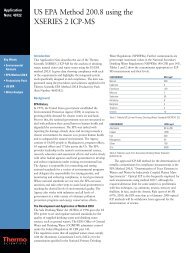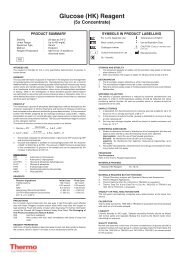Gamma Glutamyl Transferase Reagent (5X Concentrate)
Gamma Glutamyl Transferase Reagent (5X Concentrate)
Gamma Glutamyl Transferase Reagent (5X Concentrate)
You also want an ePaper? Increase the reach of your titles
YUMPU automatically turns print PDFs into web optimized ePapers that Google loves.
<strong>Gamma</strong> <strong>Glutamyl</strong> <strong>Transferase</strong> <strong>Reagent</strong><br />
(<strong>5X</strong> <strong>Concentrate</strong>)<br />
V<br />
PRODUCT SUMMARY<br />
Stability : 14 days at 2-8°C<br />
Linear Range : Up to 600 U/L<br />
Specimen Type : Serum<br />
Method : Kinetic<br />
<strong>Reagent</strong> Preparation : Add 7 mL of distilled or<br />
deionised water.<br />
INTENDED USE<br />
This reagent is intended for the in vitro quantitative determination gammaglutamyltransferase<br />
(GGT) [(γ-<strong>Glutamyl</strong>) - Peptide: Amino Acid γ-<strong>Glutamyl</strong>transferase,<br />
EC2.3.2.2], in human serum.<br />
SUMMARY<br />
Although gamma-glutamyltransferase (GGT) is present in a variety of tissues, the<br />
serum enzyme appears to be primarily from the hepato-biliary system. Consequently,<br />
GGT is elevated in all forms of liver disease or damage. It is clinically useful in<br />
detecting obstructive jaundice, cholangitis, and cholecystitis.<br />
Elevated levels are also observed with drug use (alcohol, sedatives, anticonvulsants<br />
and tranquilizers). 1<br />
PRINCIPLE<br />
The first commercially available kinetic methods for the determination of GGT were<br />
based on the work of Szasz 2 , Rosalki and Tarlow 3 . These methods utilised γ-glutamylp-nitroanilide<br />
(Glu-4-NA) as the substrate, however the poor solubility and stability of<br />
Glu-4-NA was a major limitation. In order to improve the method Persijn 4 investigated<br />
further with Glu-4-NA derivatives and found that γ-glutamyl-3-carboxy-4-nitroanilide<br />
(Glucana) was superior to the Glu-4-NA with respect to both solubility and stability.<br />
The Glucana substrate now forms the basis of the IFCC and ECCLS recommended<br />
procedures. The GGT- Soluble Substrate method utilises Glucana in a one step<br />
method in which the reaction is initiated with the addition of sample. GGT present<br />
in the sample catalyzes the transfer of the glutamyl group from the substrate to<br />
glycylglycine forming glutamylglycylglycine and 5-amino-2-nitrobenzoate.<br />
L-γ-glutamyl-3-carboxy-4-nitroanilide + glycylglycine<br />
<br />
SYMBOLS IN PRODUCT LABELLING<br />
For in vitro diagnostic use<br />
Batch code/Lot number<br />
Catalogue number<br />
Consult instructions for use<br />
Xn - Harmful<br />
STORAGE AND STABILITY<br />
1. The unopened reagents are stable until the expiration date stated on the label<br />
when stored at 2-8°C.<br />
2. After reconstitution the reagent is stable for 14 days when stored on the Olympus<br />
Demand or Reply at 2-8°C.<br />
DETERIORATION<br />
1. The dry powder reagent should be a white to off-white, free flowing powder.<br />
2. The reconstituted reagent should be a clear, slightly yellow solution.<br />
3. Failure to achieve assay values on freshly prepared control sera could indicate<br />
deterioration.<br />
SPECIMEN COLLECTION<br />
Clear, non-hemolyzed serum is the recommended sample. 5<br />
SAMPLE STORAGE<br />
GGT is stable for 7 days when stored at 2-8°C. 6<br />
INTERFERING SUBSTANCES<br />
1. No interference from Lipemia, measured as triglycerides, up to 200 mg/dL.<br />
2. No interference from Conjugated Bilirubin up to 60 mg/dL.<br />
3. No interference from Free Bilirubin up to 48 mg/dL.<br />
4. No interference from Hemoglobin up to 350 mg/dL.<br />
5. Young has reviewed drug effects on serum GGT levels. 6<br />
PROCEDURE<br />
Test Parameters<br />
Refer to the Thermo <strong>Reagent</strong> Applications.<br />
Temperature Limitation<br />
Use by/Expiration Date<br />
CAUTION. CONSULT INSTRUCTIONS<br />
FOR USE.<br />
Manufactured by<br />
GGT<br />
MATERIALS PROVIDED<br />
GGT <strong>Reagent</strong><br />
10 x 7 mL<br />
L-γ-glutamylglycylglycine + 5-amino-2-nitrobenzoate<br />
The rate of formation of 5-amino-2-nitrobenzoate is proportional to the activity of GGT<br />
present in the sample and can be measured bichromatically at 410/660nm.<br />
REAGENTS<br />
Reactive Ingredients Initial Conc. Final Conc.<br />
Tris buffer 550 mmol/L 110 mmol/L<br />
Glycylglycine 550 mmol/L 110 mmol/L<br />
L-γ-glutamyl-3-carboxy-4-nitroanilide 16 mmol/L 3.2 mmol/L<br />
Also contains non-reactive fillers and stabilizers<br />
pH 8.20 ± 0.1 at 20°C<br />
PRECAUTIONS<br />
Do not ingest. Avoid contact with skin and eyes. If spilt thoroughly wash affected<br />
area with water. <strong>Reagent</strong> contains sodium azide which may react with copper or<br />
lead plumbing. Flush with plenty of water when disposing. For further information<br />
consult the Bicarbonate <strong>Reagent</strong> Material Safety Data Sheet. The Packaging of<br />
This Product Contains Dry Natural Rubber.<br />
R22 Harmful if swallowed.<br />
R36/38 Irritating to eyes and skin.<br />
S26 In case of contact with eyes, rinse immediately with plenty of water<br />
and seek medical advice.<br />
REAGENT PREPARATION<br />
Add 7 mL of freshly distilled or deionized water to each vial. Swirl gently to dissolve<br />
the contents. Allow to stand 10 minutes at room temperature before use.<br />
MATERIALS REQUIRED BUT NOT PROVIDED<br />
1. Clinical chemistry analyser capable of maintaining constant temperature<br />
(37°C), using 5x concentrated reagents and measuring absorbance at<br />
405 nm (405 - 420 nm)<br />
2. Thermo <strong>Reagent</strong> Applications for the Olympus Demand or Reply.<br />
3. Thermo Data-Trol N and Data-Trol A (Cat. No. 1902-050 or TR40001 and<br />
1901-050 or TR41001) or equivalent.<br />
STABILITY OF FINAL REACTION MIXTURE<br />
The instrument automatically computes every determination at the same time<br />
interval.<br />
CALIBRATION<br />
A calibrator is not required for the GGT Procedure. One U/L of GGT activity is that<br />
amount of enzyme which produces one mmol/L of p-nitroaniline per minute.<br />
LINEARITY<br />
Linearity extends to 600 U/L. Samples exceeding linearity should be diluted with<br />
normal saline and repeated. Multiply the result by the dilution factor when calculating<br />
the unknown.<br />
QUALITY CONTROL<br />
Normal and abnormal control sera of known concentrations of GGT should be<br />
analyzed routinely with each group of unknown samples. Data-Trol N and Data-Trol<br />
A (Cat. No. 1902-050 or TR40001 and 1901-050 or TR41001) are recommended<br />
for this purpose.<br />
CALCULATION OF RESULTS<br />
Results, expressed as U/L at 37°C, are automatically calculated.
LIMITATIONS<br />
See Storage and Stability, Deterioration, Specimen Collection, Interfering Substances,<br />
Sample Storage, and Linearity sections for limitations to this procedure.<br />
EXPECTED VALUES 3<br />
At 37°C : Males: < 50 U/L<br />
Females: < 30 U/L<br />
The quoted values are representative of the expected range for this method and<br />
should serve as a guide only. It is recommended that each laboratory verify this<br />
range or derives a reference interval for the population that it serves. 7<br />
PERFORMANCE CHARACTERISTICS<br />
Precision<br />
WITHIN-RUN Level 1 Level 2<br />
No. of data points 20 20<br />
Mean U/L 20 67<br />
SD 0.41 1.00<br />
CV% 2.05 1.49<br />
BETWEEN DAY Level 1 Level 2<br />
No. of data points 20 20<br />
Mean U/L 22 67<br />
SD 1.80 2.05<br />
CV% 8.18 3.06<br />
COMPARISON STUDIES<br />
A comparison of the Thermo GGT reagent (y) with a commercial reagent of the same<br />
methodology (x) was performed on 147 human samples in a range of 2 - 831 U/L.<br />
A correlation coefficient of 0.999 was obtained; the linear regression equation was<br />
y = 0.99 x + 2.7.<br />
ANALYTICAL SENSITIVITY<br />
Based on an instrument resolution of A= 0.001, this Thermo GGT Procedure has<br />
a sensitivity of 2.6 U/L.<br />
REFERENCES<br />
1. Kachmar JF, Moss DV. “Enzymes” in Fundamentals of Clinical Chemistry. Tietz<br />
NW (Ed) WB Saunders Co. Philadelphia 1976; page 621-3.<br />
2. Szasz G. Clin Chem 1969; 15: 124-36.<br />
3. Rosalki SB, Tarlow D. Clin Chem 1974; 20: 1121-4.<br />
4. Persijn JP and van der Slik W. J.Clin.Chem.Clin Biochem. 1976; 14: 421-7.<br />
5. Tietz, N.W., Clinical Guide to Laboratory Tests, W.B. Saunders, Philadelphia,<br />
1983, p. 244.<br />
6. Young DS. Effects of Drugs on Clinical Laboratory Tests. Third Edition. 1990;<br />
3: 183-5.<br />
7. Wachtel M et al, Creation and Verification of Reference Intervals. Laboratory<br />
Medicine 1995; 26:593-7.<br />
© 2006 Thermo Electron Corporation. All rights reserved..<br />
Thermo Electron<br />
189-199 Browns Road,<br />
Noble Park, Victoria, 3174<br />
AUSTRALIA<br />
Phone: (03) 9790 4100<br />
Fax: (03) 9790 4155<br />
Email: sales.clinicalchemistry@thermo.com<br />
www.thermo.com/clinicalchemistry<br />
Thermo Electron<br />
171 Industry Drive<br />
Pittsburgh, PA, 15275<br />
U.S.A.<br />
Phone: (800) 558 9115<br />
Fax: (412) 788 6833<br />
Reorder Information and Technical Support<br />
Catalogue No.<br />
Configuration<br />
7200-016A 10 x 7 mL<br />
Australia International U.S.A.<br />
Phone 1800 333 110 61 3 9790 4100 (800) 558 9115<br />
Facsimile (03) 9790 4155 61 3 9790 4155 (412) 788 6833<br />
P/N: PI191041.01 Rev 12/2006


